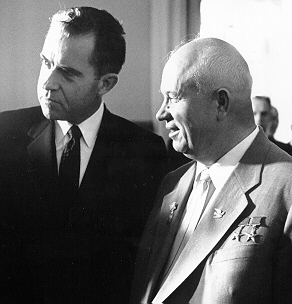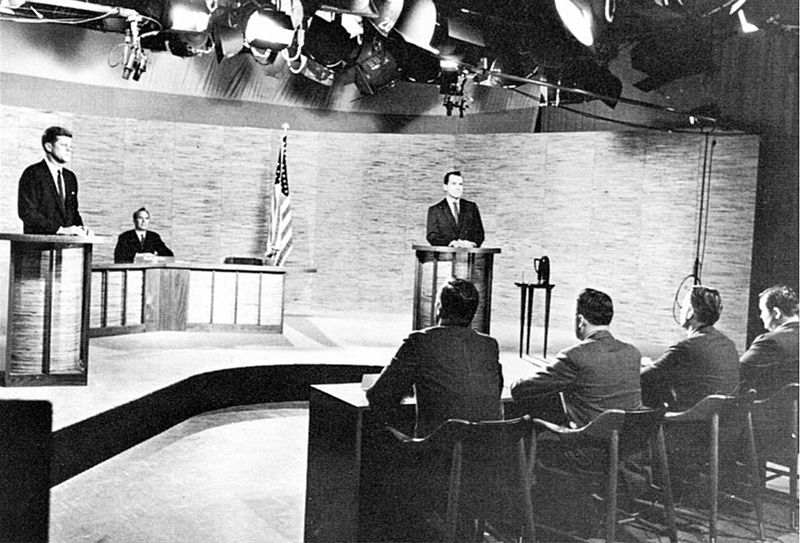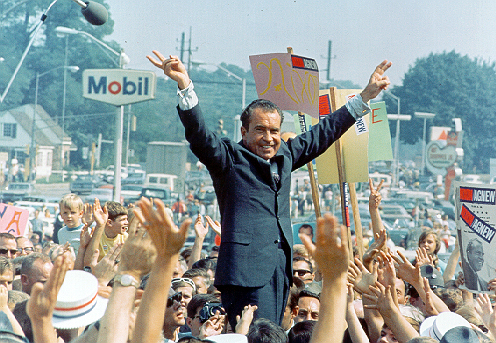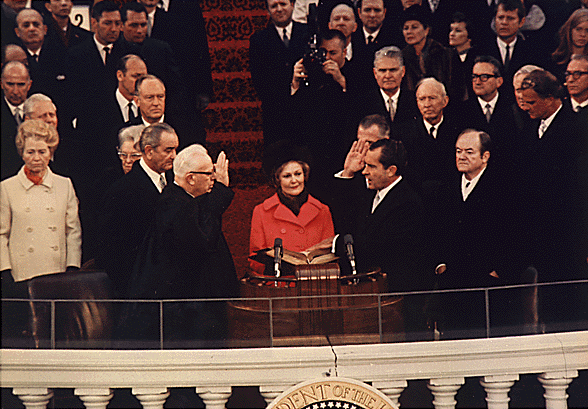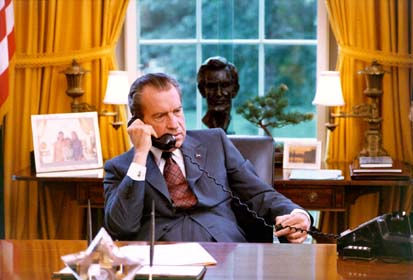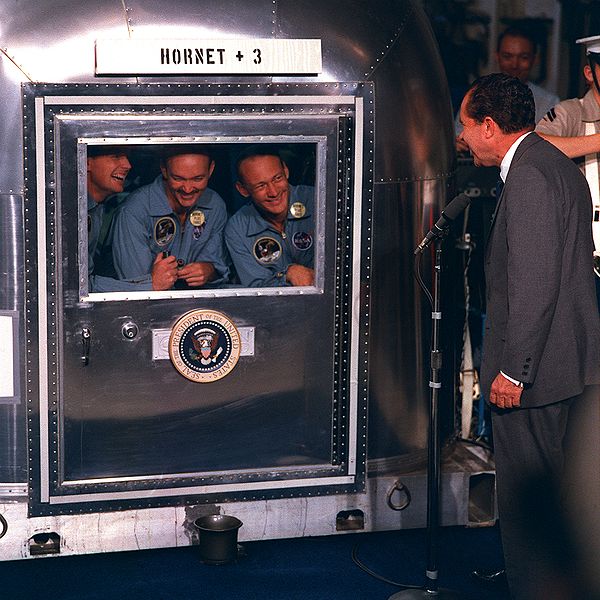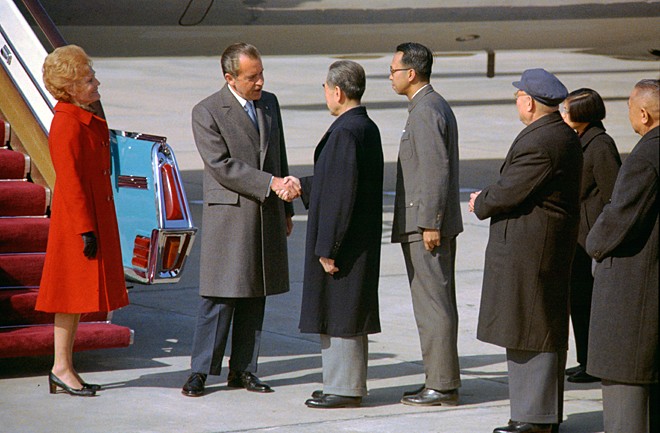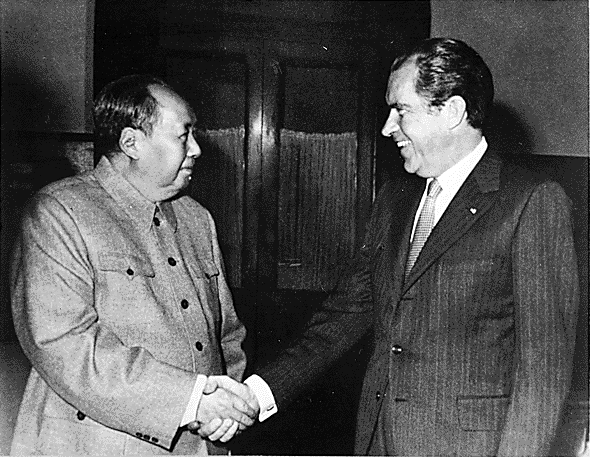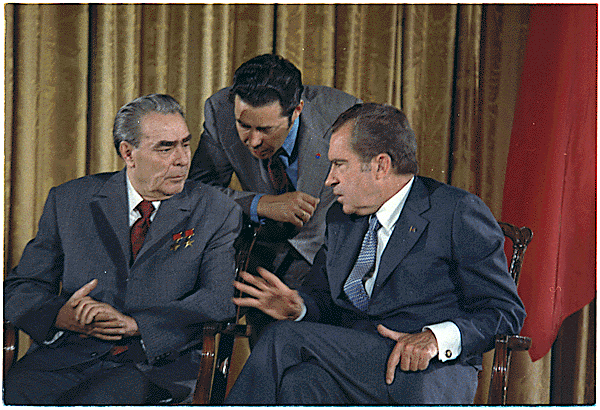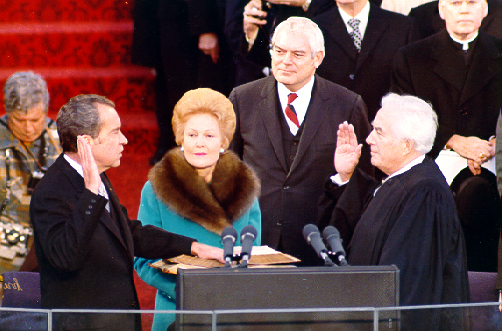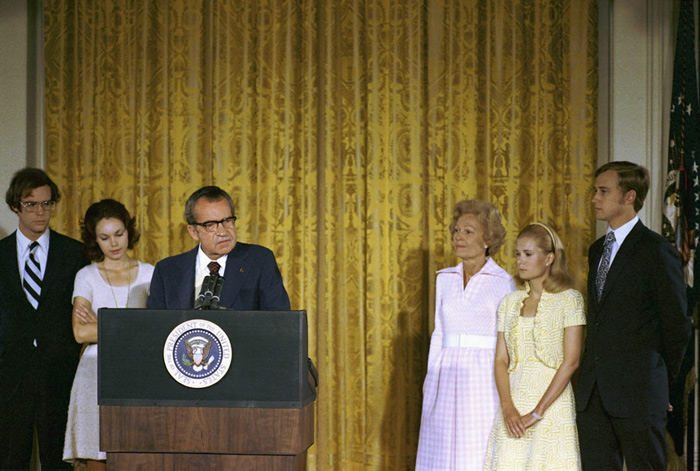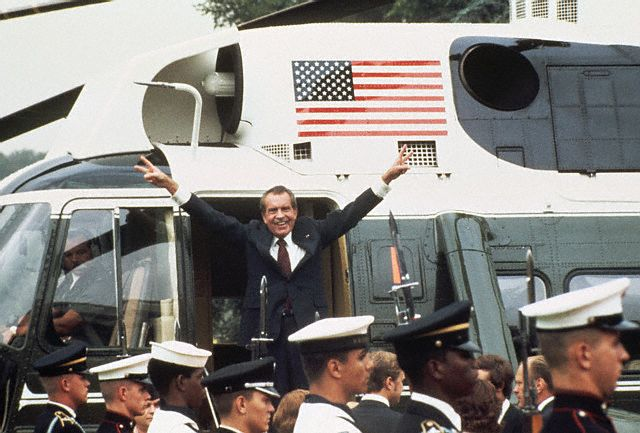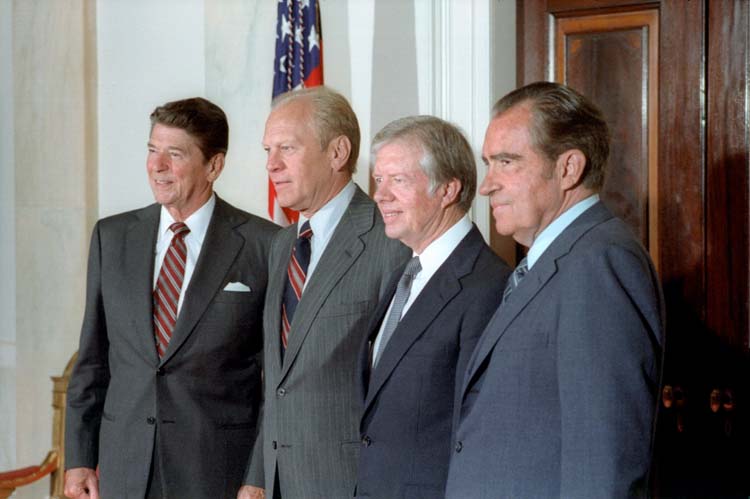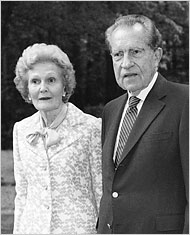<Back to Index>
- Chemist Søren Peder Lauritz Sørensen, 1868
- Poet Hayim Nahman Bialik, 1873
- 37th President of the United States Richard Milhous Nixon, 1913
PAGE SPONSOR
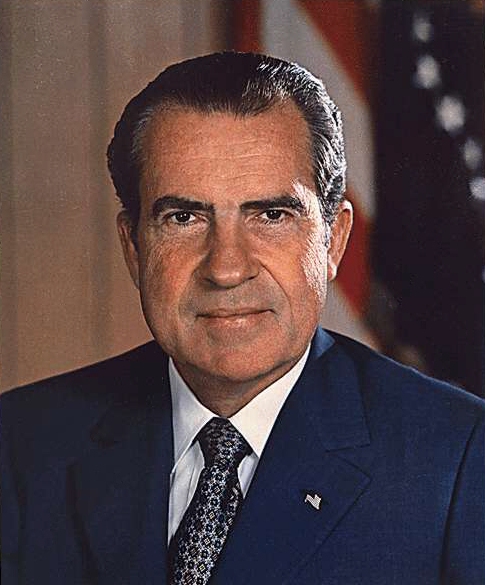
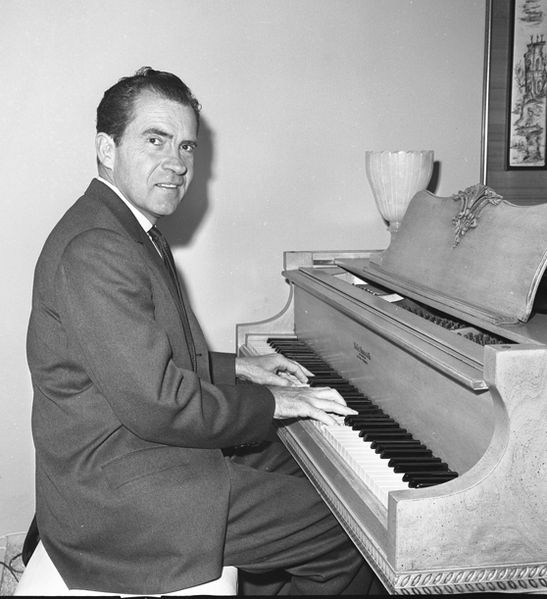
Richard Milhous Nixon (January 9, 1913 – April 22, 1994) was the 37th President of the United States from 1969 to 1974, having formerly been the 36th Vice President of the United States from 1953 to 1961. A member of the Republican Party, he was the only President to resign the office as well as the only person to be elected twice to both the Presidency and the Vice Presidency.
Nixon was born in Yorba Linda, California. After completing his undergraduate work at Whittier College, he graduated from Duke University School of Law in 1937 and returned to California to practice law in La Habra. Following the attack on Pearl Harbor, he joined the United States Navy, serving in the Pacific theater, and rose to the rank of Lieutenant Commander during World War II. He was elected in 1946 as a Republican to the House of Representatives representing California's 12th Congressional district, and in 1950 to the United States Senate. He was selected to be the running mate of Dwight D. Eisenhower, the Republican Party nominee, in the 1952 Presidential election, becoming one of the youngest Vice Presidents in history. He waged an unsuccessful presidential campaign in 1960, narrowly losing to John F. Kennedy, and an unsuccessful campaign for Governor of California in 1962;
following these losses, Nixon announced his withdrawal from political
life. In 1968, however, he ran again for president of the United States
and was elected. The most immediate task facing President Nixon was a resolution of the Vietnam War.
He initially escalated the conflict, overseeing incursions into
neighboring countries, though American military personnel were
gradually withdrawn and he successfully negotiated a ceasefire with North Vietnam in 1973, effectively ending American involvement in the war. His foreign policy initiatives were largely successful: his groundbreaking visit to the People's Republic of China in 1972 opened diplomatic relations between the two nations, and he initiated détente and the Anti - Ballistic Missile Treaty with the Soviet Union. On the domestic front, he implemented the concept of New Federalism, transferring power from the federal government to the states; new economic policies which called for wage and price control and the abolition of the gold standard; sweeping environmental reforms, including the Clean Air Act and creation of the EPA; the launch of the War on Cancer and War on Drugs; reforms empowering women, including Title IX; and the desegregation of schools in the deep South. He was reelected by a landslide in
1972. He continued many reforms in his second term, though the nation
was afflicted with an energy crisis. In the face of likely impeachment for his role in the Watergate scandal, Nixon resigned on August 9, 1974. He was later pardoned by his successor, Gerald Ford, for any federal crimes he may have committed while in office.
In
his retirement, Nixon became a prolific author and undertook many
foreign trips. His work as an elder statesman helped to rehabilitate
his public image. He suffered a debilitating stroke on April 18, 1994, and died four days later at the age of 81. Nixon was born on January 9, 1913, to Francis A. Nixon and Hannah Milhous Nixon in a house his father had built in Yorba Linda, California. His mother was a Quaker,
and his upbringing was marked by conservative Quaker observances of the
time, such as refraining from drinking, dancing, and swearing. His
father converted from Methodism to Quakerism after his marriage. Nixon had four brothers: Harold (1909 – 1933), Donald (1914 – 1987), Arthur (1918 – 1925), and Ed (born 1930). Four of the five of the Nixon boys were named after early English kings; Richard was named after Richard the Lionheart. Nixon's
early life was marked by hardship, and he would later quote a saying of
Eisenhower to describe his boyhood, "We were poor, but the glory of it
was, we didn't know it." The Nixon family ranch failed in 1922, and the family then moved to East Whittier, California, in an area with many Quakers, where his father opened a grocery score and gas station. Richard's younger brother Arthur died in 1925 after a short illness, and his older brother Harold, whom Richard greatly admired, died of tuberculosis in 1933. Historian David Reynolds summarises :
"His father was a violent bully, his mother a devoted Quaker and home
maker, yet the young Richard drew no real warmth from her; there
were few hugs and kisses. Much of his mother's energy was expended on
his sickly brothers. Richard grew up insecure, withdrawn and
emotionally bottled-up - yet these trials spurred a fierce ambition." Nixon attended Fullerton High School in Fullerton, but later he transferred to Whittier High School, where he graduated second in his class in 1930. He
lost the 1929 student body presidential election at Whittier to a more
popular student, a loss which wounded him, but would be his last
electoral defeat for 31 years. Richard was offered a scholarship to Harvard,
but his family lacked the money for him to travel to and live in the
East; he instead lived at home and took up a scholarship to Whittier
College, a local Quaker school, where he co-founded a fraternity known as The Orthogonian Society. Nixon was a formidable debater, standout in collegiate drama productions, student body president, and was on the college baseball, football and track teams. While at Whittier, he lived at home and worked at his family's store; he also taught Sunday school at
East Whittier Friends Church, where he remained a member all his life.
In 1934, he graduated second in his class from Whittier. In 1933, Nixon became engaged to Ola Florence Welch; daughter of the Whittier police chief; the two broke up in 1935. Nixon received a full scholarship to Duke University School of Law. At the time, the law school was new and sought to attract the top students by offering scholarships. This
high expense approach to building a law school applied to the faculty
as well, which was given high salaries; most professors had national or
international reputations. The
number of scholarships were greatly reduced for second and third year
students, forcing the students into intense competition. Nixon was elected president of the Duke Bar Association and graduated third in his class in June 1937. Nixon
later spoke about the influence of his alma mater, saying, "I always
remember that whatever I have done in the past or may do in the future, Duke University is responsible in one way or another." Although Nixon's first choice was to get a job with the Federal Bureau of Investigation, he returned to California and was admitted to the bar in 1937. He began practicing with Wingert and Bewley, where he worked on commercial litigation for local petroleum companies and other corporate matters as well as on wills. By
his own admission, Nixon would not work on divorce because he was
"severely embarrassed by women's confessions of sexual misconduct."
Nixon found the practice of law unexciting, but thought that it would
gain him experience that would be beneficial in a future political
career. In 1938, he opened up his own branch of Wingert and Bewley in La Habra, California, becoming a full partner in the firm the following year. In January 1938, Nixon was cast in the Whittier Community Players production of The Dark Tower. There he played opposite a high school teacher named Thelma "Pat" Ryan. Nixon
pursued her, but initially Ryan was not interested in a relationship.
He began making unannounced visits to her home and would take her on
Sunday drives to the Quaker Sunday School where he was a teacher. After
several proposals, Ryan eventually agreed to marry Nixon and they wed
at a small ceremony on June 21, 1940. After a honeymoon in Mexico, the Nixons moved to Long Beach, then settled into an apartment in East Whittier a few months later. In January 1942, they moved to Washington, D.C., where Richard Nixon took a job at the Office of Price Administration.
Nixon was eligible for an exemption from military service, both as a Quaker and through his job working for the OPA, but he did not seek one and was commissioned into the United States Navy in August 1942. He was trained at Naval Air Station Quonset Point, Rhode Island, and was assigned to Ottumwa Naval Air Station, Iowa, for seven months. He was subsequently reassigned as the naval passenger control officer for the South Pacific Combat Air Transport Command, supporting the logistics of operations in the South West Pacific theater. After requesting more challenging duties, he was given command of cargo handling units. Nixon returned to the United States with two service stars (although he saw no actual combat) and a citation of commendation, and became the administrative officer of the Alameda Naval Air Station. In January, 1945, he was transferred to Philadelphia's Bureau of Aeronautics office to help negotiate the termination of war contracts. There he received another letter of commendation, this time from Secretary of the Navy James Forrestal. In October 1945, he was promoted to lieutenant commander. He resigned his commission on New Year's Day 1946.
Soon after World War II ended, a group of Whittier Republicans approached Nixon about running for a seat in the United States House of Representatives. Nixon accepted their offer, and waged a campaign which ended in a victory over the five-term Democratic incumbent Jerry Voorhis in November 1946. Nixon represented southern California's 12th Congressional district for the next four years. He helped finance the campaign with his World War II poker winnings. In Congress, Nixon supported the Taft - Hartley Act of 1948, and served on the Education and Labor Committee. He was part of the Herter Committee, which went to Europe to prepare a preliminary report on the newly enacted Marshall Plan.
Nixon first gained national attention in 1948 when his investigation on the House Un-American Activities Committee (HUAC) broke the impasse of the Alger Hiss spy case. While many doubted Whittaker Chambers' allegations that Hiss, a high State Department official, was a Soviet spy, Nixon believed the allegations to be true. He discovered that Chambers saved microfilm reproductions of incriminating documents by hiding the film in a pumpkin. They were alleged to be accessible only to Hiss and to have been typed on his personal typewriter. Hiss was convicted of perjury in
1950 for statements he made to the HUAC. The discovery that Hiss
committed perjury and thus may well have been a Soviet spy thrust Nixon
into the spotlight for the first time. This case turned the young Congressman into a controversial figure. He was easily reelected in 1948. In the 1950 mid-term elections, Nixon ran against Democratic Representative Helen Gahagan Douglas for a seat in the U.S. Senate, representing California. The campaign is best remembered as one of the most contentious of the times. Nixon felt the former actress was a left-wing sympathizer, labeling her "pink right down to her underwear." Conversely, Douglas referred to Nixon as "Tricky Dick", a derisive nickname which remained with him for the rest of his life. In the November election, Nixon defeated Douglas. In the Senate, Nixon took a prominent position in opposing the spread of global communism, traveling frequently and speaking out against "the threat." He also criticized what he perceived to be President Harry S. Truman's mishandling of the Korean War. He supported statehood for Alaska and Hawaii, voted in favor of civil rights for minorities, and supported federal disaster relief for India and Yugoslavia. He voted against price controls and other monetary controls, benefits for illegal immigrants, and public power.
In
part because of his reputation as an ardent anti-communist, 39 year old
Nixon was selected by Republican party nominee General Dwight D. Eisenhower to be the Vice Presidential candidate at the Republican National Convention in July 1952. In September, the New York Post published
an article claiming that campaign donors were buying influence with
Nixon by providing him with a secret cash fund for his personal
expenses. Nixon
responded that the fund was not secret, and the campaign commissioned
an independent review which showed that it was used only for political
purposes. Republicans,
including some within Eisenhower's campaign, pressured Eisenhower to
remove Nixon from the ticket, but Eisenhower realized that he was
unlikely to win without Nixon. Nixon
appeared on television on September 23, 1952, to defend himself against
the allegations. He detailed his personal finances and mentioned the
independent third party review of the fund's accounting. While
it was the first time that a national politician released his tax
returns, the speech became best known for its rhetoric, such as his
remark that his wife Pat did not wear mink, but rather "a respectable
Republican cloth coat," and that, although he had been given an American Cocker Spaniel named
Checkers in addition to his other campaign contributions, he was not
going to give the dog back because his daughters loved it. It became known as the "Checkers speech", it resulted in much support from the base of the Republican Party and from the general public, and greatly aided Nixon in remaining on the ticket. In the 1952 presidential elections, Eisenhower and Nixon defeated Illinois Governor Adlai Stevenson and Alabama Senator John Sparkman by seven million votes. Nixon assumed the office as the second youngest Vice President in American history.
As Vice President, Nixon expanded the office into an important and prominent post. Nixon conducted National Security meetings in the president's absence. As President of the Senate, he intervened to make procedural rulings on filibusters to assure the passage of Eisenhower's 1957 civil rights bill, which created the United States Commission on Civil Rights and protected voting rights. Although
he had little formal power, Nixon had the attention of the media and
the Republican Party. Using these, he and his wife undertook many
foreign trips of goodwill to garner support for American policies
during the Cold War. On one such trip to Caracas, Venezuela, anti - American protesters disrupted
and assaulted Nixon's motorcade, pelting his limousine with rocks,
shattering windows, and injuring Venezuela's foreign minister. Nixon was lauded and attracted international media attention for his appearance of calm and coolness during the incidents. In March 1957, he visited Libya for a program of economic and military aid. Nixon
was, and is still, the highest ranking U.S. official to visit the
African nation. In July 1959, President Eisenhower sent Nixon to the Soviet Union for Moscow's opening of the American National Exhibition. Before
his visit, Nixon cautioned: "There is no magic formula which will
settle the differences between us, no conference at the Summit which
will dramatically end world tensions. The road to peace is a long and a
hard one, and if we are to stay on it, both our people and our leaders
must display patience and understanding to a maximum degree." On July 24, while touring the exhibits with Soviet General Secretary Nikita Khrushchev, the two stopped at a model of an American kitchen and engaged in an impromptu exchange that became known as the "Kitchen Debate" about the merits of capitalism versus communism. As Vice President, he officially opened the 1960 Winter Olympics in Squaw Valley, California. In
1960, Nixon launched his campaign for President of the United States.
He faced little opposition in the Republican primaries. In his
acceptance speech after winning the nomination at the Republican
convention, Nixon said: "I can only say tonight to you that I believe
in the American dream because I have seen it come true in my own life.
With faith in America, with faith in her ideals and in her people I
accept her nomination for President of the United States." He chose former Massachusetts Senator Henry Cabot Lodge, Jr. as his running mate. His Democratic opponent was John F. Kennedy, and the race remained close for the duration. Nixon campaigned on his experience, but Kennedy called for new blood and claimed the Eisenhower - Nixon administration allowed the Soviet Union to overtake the U.S. in ballistic missiles (the "missile gap"). Kennedy told voters it was time to "get the country moving again." In the midst of the campaign, Nixon advocated stimulative tax cuts in what would become one of the core tenets of the supply side theory of economics. He also presented a plan for economic growth and deficit reduction, which appealed to many. A new medium was brought to the campaign: televised presidential debates.
In the first of four such debates, Nixon was recovering from illness
and, wearing little makeup, looked wan and uncomfortable, in contrast
to the composed Kennedy. Nixon's
performance in the debate was perceived to be mediocre in the visual
medium of television, though many people listening on the radio thought
that Nixon had won. Nixon lost the election narrowly, with Kennedy ahead by only 120,000 votes (0.2%) in the popular vote. There were charges of vote fraud in Texas and Illinois; Nixon supporters unsuccessfully challenged results in both states as well as nine others. After
all the court battles and recounts were done, Kennedy had a greater
number of electoral votes than he held after Election Day. Nixon halted further investigations to avoid a Constitutional crisis. Nixon
and Kennedy later met in Key Biscayne, Florida, where Kennedy offered
Nixon a job in his administration, an offer which Nixon declined. Following his loss to Kennedy, Nixon and his family returned to California, where he practiced law and wrote a bestselling book, Six Crises. It
recorded his political involvement as a congressman, senator and vice
president and used six different crises Nixon had experienced throughout his political career to illustrate his political memoirs. The work won praise from many policy experts and critics. It also found a favorable critic in Mao Zedong, who referred to the book during Nixon's visit in 1972. Local and national Republican leaders encouraged Nixon to challenge incumbent Pat Brown for Governor of California in the 1962 election. Despite initial reluctance, Nixon entered the race. The
campaign was clouded by public suspicion that Nixon viewed the
governorship as a political "stepping-stone" to a higher office, some
opposition from the far-right of the party, and his own lack of
interest in being California's governor. He lost to Brown by nearly 300,000 votes. This loss was widely believed to be the end of his career; in
an impromptu concession speech the morning after the election, Nixon
famously blamed the media for favoring his opponent, saying, "You won't
have Nixon to kick around anymore because, gentlemen, this is my last press conference." The California defeat was highlighted in the November 11, 1962, episode of ABC's Howard K. Smith: News and Comment entitled "The Political Obituary of Richard M. Nixon." The Nixon family traveled to Europe in 1963; Nixon gave press conferences and met with leaders of the countries he visited. The family soon moved to New York City, where Nixon became a senior partner in the leading law firm Nixon, Mudge, Rose, Guthrie & Alexander. In 1963 the family bought an apartment at 810 Fifth Avenue. Nelson Rockefeller lived upstairs, and during the Presidential campaign of 1968 the two used different entrances and elevators. In March - April 1964 he made a trip to Asia, which included South Vietnam and Japan.
During and immediately after the trip, he made many media appearances
in which he called on the Johnson Administration to escalate the
struggle against communism in South East Asia to the point of invading
North Vietnam and Laos. Though
largely out of the public eye, he was still supported by much of the
Republican base who respected his knowledge of politics and
international affairs. This reputation was enhanced when Nixon wrote an article in Foreign Affairs entitled "Asia After Vietnam", in which he proposed a new relationship with China. He campaigned for Republican candidates in the 1966 Congressional elections and took an extended trip to South America and parts of the Middle East in 1967. Toward
the end of 1967, Nixon was experiencing a crisis of indecision about
whether to run for president the following year. He consulted with
longtime friend the Reverend Billy Graham, who urged him to run. He later held a dinner at his home with friends and all except his wife supported a presidential bid. He formally announced his candidacy for president of the United States on February 1, 1968. Throughout the campaign, Nixon portrayed himself as a figure of stability during a period of national unrest and upheaval. He appealed to what he called the "silent majority" of socially conservative Americans who disliked the hippie counterculture and the anti-war demonstrators, and secured the nomination in August. His running mate, Maryland governor Spiro Agnew, became an increasingly vocal critic of these groups, solidifying Nixon's position with the right. Nixon
waged a prominent television campaign, meeting with supporters in front of cameras and advertising on the television medium. He
stressed that the crime rate was too high, and attacked what he
perceived as a surrender by the Democrats of the United States' nuclear
superiority. His campaign was aided by turmoil within the Democratic Party: President Lyndon B. Johnson, consumed with the Vietnam War, announced that he would not seek reelection. After a contentious Democratic primary campaign, Vice President Hubert Humphrey held a moderate but not decisive lead over Senator Robert F. Kennedy; however, Kennedy was assassinated in Los Angeles following the final, California primary. Humphrey was nominated at a convention marked by mass protests. Nixon appeared to represent a calmer society. With regard to the Vietnam War, he promised peace with honor, and campaigned on the notion that "new leadership will end the war and
win the peace in the Pacific." He did not give specific plans on how to
end the war, resulting in media intimations that he must have a "secret plan". His slogan of "Nixon's the One" proved to be effective. In a three-way race between Nixon, Humphrey, and independent candidate George Wallace, Nixon defeated Humphrey by nearly 500,000 votes to become the 37th President of the United States on November 5, 1968. In
response to a congratulatory message from Humphrey, Nixon said: "I have
received a very gracious message from the Vice President,
congratulating me for winning the election. I congratulated him for his
gallant and courageous fight against great odds. I also told him that I
know exactly how he felt. I know how it feels to lose a close one." Nixon was inaugurated on January 20, 1969. Pat Nixon held the family Bibles open to Isaiah 2:4, reading, "They shall beat their swords into plowshares, and their spears into pruning hooks." In
his inaugural address, which received almost uniformly positive
reviews, Nixon remarked that "the greatest honor history can bestow is
the title of peacemaker." He spoke about turning partisan politics into a new age of unity: In
these difficult years, America has suffered from a fever of words; from
inflated rhetoric that promises more than it can deliver; from angry
rhetoric that fans discontents into hatreds; from bombastic rhetoric
that postures instead of persuading. We cannot learn from one another
until we stop shouting at one another, until we speak quietly enough so
that our words can be heard as well as our voices.” Nixon
set out to reconstruct the Western Alliance, develop a relationship
with China, pursue arms control agreements with the Soviet Union,
activate a peace process in the Middle East, restrain inflation,
implement anti-crime measures, accelerate desegregation, and reform
welfare. The most immediate task, however, was the Vietnam War. When
Nixon took office, 300 American soldiers were dying per week in
Vietnam. The Johnson administration had negotiated a deal in which the
U.S. would suspend bombing in North Vietnam in exchange for
unconditional negotiations, but this faltered. Nixon faced the choice
of devising a new policy to chance securing South Vietnam as a
non-communist state, or withdrawing American forces completely. Nixon approved a secret bombing campaign of North Vietnamese positions in Cambodia in March 1969 (code-named Operation Menu) to destroy what was believed to be the headquarters of the National Front for the Liberation of Vietnam. The Air Force considered the bombings a success. He
then proposed simultaneous substantial withdrawals of North Vietnamese
and American forces from South Vietnam one year after reaching a mutual
agreement. In
June 1969, in a campaign fulfillment, Nixon reduced troop strength in
Vietnam by 25,000 soldiers, who returned home to the United States.
From 1969 to 1972 troop reduction in Vietnam was estimated to be
405,000 soldiers. In July 1969, the Nixons visited South Vietnam, where President Nixon met with his U.S. military commanders and President Nguyen Van Thieu. Amid protests at home, he implemented what became known as the Nixon Doctrine, a strategy of replacing American troops with Vietnamese troops, also called "Vietnamization". He soon enacted phased U.S. troop withdrawals but authorized incursions into Laos, in part to interrupt the Ho Chi Minh trail that
passed through Laos and Cambodia. Nixon's 1968 campaign promise to curb
the war and his subsequent Laos bombing raised questions in the press
about a "credibility gap", similar to that encountered earlier in the war by Lyndon B. Johnson. In a televised speech on April 30, 1970, Nixon announced the incursion of U.S. troops into Cambodia to disrupt so-called North Vietnamese sanctuaries. This led to protest and student strikes that temporarily closed 536 universities, colleges, and high schools. Nixon formed the Gates Commission to look into ending the military service draft, implemented
under President Johnson. The Gates Commission issued its report in
February 1970, describing how adequate military strength could be
maintained without conscription. The draft was extended to June 1973, and then ended. Military pay was increased as an incentive to attract volunteers, and television advertising for the United States Army began for the first time. In December 1972, though concerned about the level of civilian casualties, Nixon approved Linebacker II, the codename for aerial bombings of military and industrial targets in North Vietnam. After years of fighting, the Paris Peace Accords were signed in 1973. The treaty, however, made no provision that 145,000 – 160,000 North Vietnam Army regulars located in the Central Highlands and other areas of S. Vietnam had to withdraw. Under President Nixon, American involvement in the war steadily declined from a troop strength of 543,000 to zero in 1973. Once American support was diminished, in 1975, North Vietnam was able to conquer South Vietnam and formed one country. Under Nixon, direct payments from the federal government to individual American citizens in government benefits (including Social Security and Medicare) rose from 6.3% of the Gross National Product (GNP)
to 8.9%. Food aid and public assistance also rose, beginning at $6.6
billion and escalating to $9.1 billion. Defense spending decreased from
9.1% to 5.8% of the GNP. The revenue sharing program pioneered by Nixon
delivered $80 billion to individual states and municipalities. In
1970, the Democratic Congress passed the Economic Stabilization Act,
giving Nixon power to set wages and prices; Congress did not believe
the president would use the new controls and felt this would make him
appear to be indecisive. While opposed to permanent wage and price controls, Nixon imposed the controls on a temporary basis in a 90 day wage and price freeze. The
controls (enforced for large corporations, voluntary for others) were
the largest since World War II; they were relaxed after the initial 90
days. Nixon then spoke to the American public, saying that by "Working together, we will break the back of inflation." A
Pay Board set wage controls limiting increases to 5.5% per year, and
the Price Commission set a 2.5% annual limit on price increases. The limits did help to control wages, but not inflation. Overall, however, the controls were viewed as successful in the short term and were popular with the public, who felt Nixon was rescuing them from price gougers and from a foreign caused exchange crisis. Nixon was worried about the effects of increasing inflation and accelerating unemployment, so he indexed Social Security for inflation, and created Supplemental Security Income (SSI). In 1969, he had presented the only balanced budget between 1961 and 1998. However, despite speeches declaring an opposition to the idea, he decided to offer Congress a budget with deficit spending to reduce unemployment and declared, "Now I am a Keynesian". Another large part of Nixon's plan was the detachment of the dollar from the gold standard. By
the time Nixon took office, U.S. gold reserves had declined from $25
billion to $10.5 billion. Gold was an underpriced commodity, as the
dollar was overpriced as a currency. The United States was on the verge
of running its first trade deficit in over 75 years. The price of gold had been set at $35 an ounce since the days of Franklin Roosevelt's
presidency; foreign countries acquired more dollar reserves,
outnumbering the entire amount of gold the United States possessed.
Nixon completely eradicated the
gold standard, preventing other countries from being able to claim gold
in exchange for their dollar reserves, but also weakening the exchange rate of the dollar against other currencies and increasing inflation by driving up the cost of imports. Nixon felt that the dollar should float freely like other currencies. Said Nixon in his speech: "The
American dollar must never again be a hostage in the hands of
international speculators.... Government... does not hold the key to
the success of a people. That key... is in your hands. Every action I
have taken tonight is designed to nurture and stimulate that
competitive spirit to help us snap out of self-doubt, the
self-disparagement that saps our energy and erodes our confidence in
ourselves... Whether the nation stays Number One depends on your
competitive spirit, your sense of personal destiny, your pride in your
country and yourself." Other
parts of the Nixon plan included the reimposition of a 10% investment
tax credit, assistance to the automobile industry in the form of removal of excise taxes (provided the savings were passed directly to the consumer), an end to fixed exchange rates, devaluation of the dollar on the free market, and a 10% tax on all imports into the U.S. Income per family rose, and unionization declined. Nixon
wanted to lift the spirits of the country as polls showed increasing
concern about the economy. His program was viewed by nearly everyone as
exceptionally bold, and astounded the Democrats. Nixon soon experienced a bounce in the polls. His economic program was determined to be a clear success by December 1971. One of Nixon's economic advisers, Herbert Stein,
wrote: "Probably more new regulation was imposed on the economy during
the Nixon administration than in any other presidency since the New Deal." Noam Chomsky remarked that, in many respects, Nixon was "the last liberal president." Indeed, Nixon believed in using government wisely to benefit all and supported the idea of practical liberalism. Nixon initiated the Environmental Decade by signing the National Environmental Policy Act, the Clean Air Act of 1970 and
the Federal Water Pollution Control Act amendments of 1972, as well as
establishing many government agencies. These included the Environmental Protection Agency (EPA), the Occupational Safety and Health Administration (OSHA), and the Council on Environmental Quality. The Clean Air Act was noted as one of the most significant pieces of environmental legislation ever signed. In
1971, Nixon proposed the creation of four new government departments
superseding the current structure: departments organized for the goal
of efficient and effective public service as opposed to the thematic
bases of Commerce, Labor, Transportation, Agriculture, et al.
Departments including the State, Treasury, Defense, and Justice would
remain under this proposal. He reorganized the Post Office Department from a cabinet department to a government owned corporation: the U.S. Postal Service. On June 17, 1971, Nixon formally declared the U.S. War on Drugs. On October 30, 1972 Nixon signed into law the Social Security Amendments of 1972 which included the creation of the Supplemental Security Income Program, a Federal Welfare Program still in existence today. Nixon cut billions of dollars in federal spending and expanded the power of the Office of Management and Budget. He established the Consumer Product Safety Commission in 1972 and supported the Legacy of parks program,
which transferred ownership of federally owned land to the states,
resulting in the establishment of state parks and beaches, recreational
areas, and environmental education centers. The Nixon years witnessed the first large-scale integration of public schools in the South. Strategically, Nixon sought a middle way between the segregationist George C. Wallace and liberal Democrats, whose support of integration was alienating some Southern white Democrats. He was determined to implement exactly what the courts had ordered — desegregation — but did not favor busing children, in the words of author Conrad Black, "all over the country to satisfy the capricious meddling of judges." Nixon, a Quaker, felt that racism was the greatest moral failure of the United States and concentrated on the principle that the law must be color-blind: "I am convinced that while legal segregation is totally wrong, forced integration of housing or education is just as wrong." Nixon tied desegregation to improving the quality of education and enforced the law after the Supreme Court, in Alexander v. Holmes County Board of Education (1969),
prohibited further delays. By the fall of 1970, two million southern
black children had enrolled in newly created unitary fully integrated
school districts; only 18% of Southern black children were still
attending all-black schools, a decrease from 70% when Nixon came to
office. Nixon's Cabinet Committee on Education, under the leadership of Labor Secretary George P. Shultz, quietly set up local biracial committees to assure smooth compliance without violence or political grandstanding. "In this sense, Nixon was the greatest school desegregator in American history," historian Dean Kotlowski concluded. Author
Conrad Black concurred: "In his singular, unsung way, Richard Nixon
defanged and healed one of the potentially greatest controversies of
the time." Daniel Patrick Moynihan,
Nixon's presidential counselor, commented in 1970 that “There has been
more change in the structure of American public school education in the
last month than in the past 100 years.” In addition to desegregating public schools, Nixon implemented the Philadelphia Plan, the first significant federal affirmative action program in 1970. Nixon also endorsed the Equal Rights Amendment after it passed both houses of Congress in 1972 and went to the states for ratification as a Constitutional amendment. Nixon
had campaigned as an ERA supporter in 1968, though feminists criticized
him for doing little to help the ERA or their cause after his election,
which led to a much stronger women's rights agenda. Nixon increased the number of female appointees to administration positions. Nixon signed the landmark laws Title IX in 1972, prohibiting gender discrimination in all federally funded schools and the Equal Employment Opportunity Act. In 1970 Nixon had vetoed the Comprehensive Child Development Act, denouncing the universal child-care bill, but signed into law Title X, which was a step forward for family planning and contraceptives. It was during the Nixon Presidency that the Supreme Court issued its Roe v. Wade ruling,
legalizing abortion. First Lady Pat Nixon had been outspoken about her
support for legalized abortion, a goal for many feminists (though there
was a significant pro-life minority faction of the Women's Liberation
Movement as well). Nixon himself did not speak out publicly on the
abortion issue, but was personally pro-choice, and believed that, in
certain cases such as rape, abortion was an option. In
1969, Nixon's first year in office, the United States sent three manned
missions to the moon, becoming the only nation in the world to do so.
On July 20, Nixon addressed Neil Armstrong and Buzz Aldrin, two of the astronauts, live over radio during their historic Apollo 11 moonwalk. Nixon also placed a telephone call to Armstrong on the moon, the longest distance phone call ever, and called it "the most historic phone call ever made from the White House." He observed their landing in the ocean from the deck of the aircraft carrier USS Hornet. All U.S. Project Apollo moon landings, and the attempted moon landing of Apollo 13, took place during Nixon's first term. On November 14, 1969, he became the first incumbent president to attend a rocket launch, Apollo 12. On January 5, 1972, Nixon approved the development of NASA's Space Shuttle program, a
decision that profoundly influenced American efforts to explore and
develop space for several decades thereafter. Under the Nixon
administration, however, NASA's budget declined. NASA Administrator Thomas O. Paine was drawing up ambitious plans for the establishment of a permanent base on the Moon by the end of the 1970s and the launch of a manned expedition to Mars as early as 1981. Nixon, however, rejected this proposal. On May 24, 1972, Nixon approved a five-year cooperative program between NASA and the Soviet space program, culminating in the Apollo - Soyuz Test Project, a joint mission of an American Apollo and a Soviet Soyuz spacecraft in 1975. A conflict broke out in Pakistan in 1971 following independence demonstrations in East Pakistan; President Yahya Khan instructed the Pakistani Army to quell the riots, resulting in widespread human rights abuses.
President Nixon liked Yahya personally, and credited him for helping to
open a channel to China; accordingly, he felt obligated to support him
in the struggle. There were limits to how far the U.S. could associate itself with Pakistan, however. American public opinion was concerned with the atrocities and the emigration of over 10 million people into India. Nixon relayed messages to Yahya, urging him to restrain Pakistani forces. His
objective was to prevent a war and safeguard Pakistan's interests,
though he feared an Indian invasion of West Pakistan that would lead to
Indian domination of the sub-continent and strengthen the position of the Soviet Union, which had recently signed a cooperation treaty with India. Nixon felt that the Soviet Union was inciting the country. Nixon met with Indian Prime Minister Indira Gandhi and did not believe her assertion that she would not invade Pakistan; he did not trust her and once referred to her as an "old witch". On December 3, Yahya attacked the Indian Air Force and Gandhi retaliated, pushing into East Pakistan. Nixon issued a statement blaming Pakistan for starting the conflict and blaming India for escalating it because he favored a cease-fire. The
United States was secretly encouraging the shipment of military
equipment from Iran, Turkey, and Jordan to Pakistan, reimbursing those
countries despite Congressional objections. A cease fire was reached on December 16 and Bangladesh was created. Relations between the Western powers and Eastern Bloc changed dramatically in the early 1970s. In 1960, the People's Republic of China publicly split from its main ally, the Soviet Union, in the Sino - Soviet Split. As tension along the border between the two communist nations reached its peak in 1969 and 1970, Nixon decided to use their conflict to shift the balance of power towards the West in the Cold War. Nixon had begun entreating China a mere month into office by sending covert messages of rapprochement through Nicolae Ceausescu of Romania and Yahya Khan of Pakistan in
December 1970. He reduced many trade restrictions between the two
countries, and silenced anti-China voices within the White House. In April 1971, the Chinese table tennis team invited the American table tennis team to attend a demonstration competition for a week in China. The invitation came upon the order of Mao Zedong himself,
who had taken note of Nixon's "subtle overtures" to improve U.S. -
Chinese relations, including the conflict in Pakistan.This
was significant in that the fifteen member table tennis team were
allowed to enter mainland China after a period of over twenty years in
which Americans, except on very rare occasions, had been denied visas (the term "ping pong diplomacy" arose from this encounter). Chinese Premier Chou En-lai,
through Pakistani intermediaries, had relayed a message to Nixon
reading: "The Chinese government reaffirms its willingness to receive
publicly in Peking a special envoy of the president of the United
States, or the U.S. secretary of state, or even the president himself." Nixon sent then-National Security Advisor Henry Kissinger on a secret mission to China in July 1971, to arrange a visit by the president and first lady. Soon, the world was stunned to learn that Nixon intended to visit Communist China the following year. In February 1972, President and Mrs. Nixon traveled to China,
where the president was to engage in direct talks with Mao and Chou.
Kissinger briefed Nixon for over forty hours in preparation. Upon
touching down, the President and First Lady emerged from Air Force One
and greeted Chou. According to Nixon biographer Stephen Ambrose: "[Nixon] knew that when his old friend John Foster Dulles had
refused to shake the hand of Chou En-lai in Geneva in 1954, Chou had
felt insulted. He knew too that American television cameras would be at
the Beijing airport to film his arrival. A dozen times on the way to
Peking, Nixon told Kissinger and Secretary of State William Rogers that
they were to stay on the plane until he had descended the gangway and
shaken Zhou Enlai's hand. As added insurance, a Secret Service agent
blocked the aisle of Air Force One to make sure the president emerged
alone." Over
one hundred television journalists accompanied the president. On
Nixon's orders, television was strongly favored over printed
publications, as it would capture the trip's visuals much better while
snubbing the print journalists Nixon despised. Nixon
and Kissinger were soon summoned to an hour long meeting with Mao and
Zhou at Mao's official private residence, where they discussed a range
of issues. Mao later told his doctor that he had been impressed by Nixon, who was forthright, unlike the leftists and the Soviets. He also said he was suspicious of Kissinger, though the National Security Advisor referred to their meeting as his "encounter with history." A formal banquet welcoming the presidential party was conducted that evening in the Great Hall of the People.
The following day, Nixon met with Chou; during this meeting he stated
that he believed “there is one China, and Taiwan is a part of China.” When not in meetings, Nixon toured architectural wonders including the Forbidden City, Ming Tombs, and the Great Wall. Americans
received their first glance into China via Pat Nixon, who toured the
city of Beijing and visited communes, schools, factories, and hospitals
accompanied by the American media. The visit ushered in a new era of Sino - American relations. Fearing the possibility of a Sino - American alliance, the Soviet Union yielded to American pressure for détente. Nixon extended the Nixon Doctrine from Vietnam to his policy toward the Soviet Union, believing that helping Iran become stronger would check the Soviets' power. To
win American friendship, both China and the Soviet Union cut back on
their diplomatic support for North Vietnam and advised Hanoi to come to
terms. Nixon laid out his strategy: "I
had long believed that an indispensable element of any successful peace
initiative in Vietnam was to enlist, if possible, the help of the
Soviets and the Chinese. Though rapprochement with China and
détente with the Soviet Union were ends in themselves, I also
considered them possible means to hasten the end of the war. At worst,
Hanoi was bound to feel less confident if Washington was dealing with
Moscow and Beijing. At best, if the two major Communist powers decided
that they had bigger fish to fry, Hanoi would be pressured into
negotiating a settlement we could accept." Having
made great progress over the last two years in U.S. - Soviet relations,
Nixon planned a second trip to the Soviet Union in 1974. He arrived in Moscow on June 27 to a welcome ceremony, cheering crowds, and a state dinner at the Grand Kremlin Palace that evening. Nixon and Brezhnev met in Yalta,
where they discussed a proposed mutual defense pact, détente,
and MIRVs. While he considered proposing a comprehensive test-ban
treaty, Nixon felt that it would take far too long to accomplish. There were not any significant breakthroughs in these negotiations.
Nixon
entered his name on the New Hampshire primary ballot on January 5,
1972, effectively announcing his candidacy for reelection. Largely assured the Republican nomination, the President had expected his Democratic opponent to be Senator Ted Kennedy, but Senator Edmund Muskie instead became the front runner, with Senator George McGovern in a close second place. Though
Muskie defeated McGovern in the New Hampshire primary, his showings
were poorer in Florida and he soon ended his campaign. Alabama Governor George Wallace entered the race as an Independent; popular in Florida, he would create havoc among the Democrats and boost Nixon's campaign. Prominent
issues of the early campaign included school busing and heated
relations between the three branches of the government. Nixon addressed
the nation on March 16 about the school busing issue, reiterating that
it was wrong to force a child onto a school bus and that busing lowered
the quality of education. He announced the Equal Education Opportunities bill that would seek a moratorium on local school busing; the bill later passed. Vietnam was still ongoing, though Nixon had reduced troop levels dramatically.
On June 10, McGovern won the California primary and secured the Democratic nomination. The following month, Nixon was renominated at the 1972 Republican National Convention. He dismissed the Democratic platform as cowardly and divisive. Nixon was ahead in most polls for the entire election cycle, and was reelected on November 7, 1972 in one of the largest landslide election victories in U.S. political history. He defeated McGovern with over 60% of the popular vote, losing only in Massachusetts and the District of Columbia. Nixon's victory made him the first former Vice President since Thomas Jefferson to win two terms as President. Nixon and Franklin Roosevelt are the only candidates in U.S. history to appear on five presidential tickets for a major party. On
October 10, 1973, Vice President Agnew resigned, amid charges of
bribery, tax evasion and money laundering from his tenure as Maryland's
governor. Nixon chose Representative Gerald Ford, Republican Minority Leader of the House of Representatives, to replace Agnew. After
he won reelection, Nixon found that inflation was increasing, and the
legislation authorizing price controls expired April 30, 1973. The Senate Democratic Caucus recommended a 90-day freeze on all profits, interest rates, and prices. Nixon re-imposed price controls in June 1973, echoing his 1971 plan, as food prices rose; this time, he focused on agricultural exports and limited the freeze to 60 days. The price controls became unpopular with the public and business people, who saw powerful labor unions as preferable to the price board bureaucracy. Business owners, however, now saw the controls as permanent rather than temporary, and voluntary compliance decreased. The controls produced food shortages, as meat disappeared from grocery stores and farmers drowned chickens rather than sell them at a loss. The controls were slowly ended, and by April 30, 1974, the control authority from Congress had lapsed. However, the controls on oil and natural gas prices persisted for several years. Nixon also dramatically increased spending on federal employees' salaries while the economy was plagued by the 1973 – 1974 stock market crash. In his 1974 State of the Union address, Nixon called for comprehensive health insurance. On February 6, 1974, he introduced the Comprehensive Health Insurance Act.
Nixon's plan would have mandated employers to purchase health insurance
for their employees, and in addition provided a federal health plan,
similar to Medicaid, that any American could join by paying on a sliding scale based on income. The
New York Daily News writes that Ted Kennedy rejected the universal
health coverage plan offered by Nixon because it wasn't everything he
wanted it to be. Kennedy later realized it was a missed opportunity to
make major progress toward his goal. The Nixon administration supported Israel, a powerful American ally in the Middle East, during the Yom Kippur War. When an Arab coalition led by Egypt and Syria attacked
in October 1973, Israel suffered initial losses and pressed European
powers for help, but (with the exception of the Netherlands) the
Europeans responded with inaction. Nixon cut through inter-departmental
squabbles and bureaucracy to initiate an airlift of American arms. By
the time the U.S. and the Soviet Union negotiated a truce, Israel had
penetrated deep into enemy territory. A long-term effect was the
movement of Egypt away from the Soviets toward the U.S. But Israel's victory came at the cost to the U.S. of the 1973 oil crisis; the members of OPEC decided to raise oil prices in response to the American support of Israel. After Nixon chose to go off the gold standard,
foreign countries increased their currency reserves in anticipation of
currency fluctuation, which caused deflation of the dollar and other
world currencies. Since oil was paid for in dollars, OPEC was receiving
less value for their product. They cut production and announced price
hikes as well as an embargo targeted
against the United States and the Netherlands, specifically blaming
U.S. support for Israel in the Yom Kippur War for the actions. On January 2, 1974, Nixon signed a bill that lowered the maximum U.S. speed limit to 55 miles per hour (88.5 km/h) to conserve gasoline during the crisis. This
law was repealed in 1995, though states had been allowed to raise the
limit to 65 miles per hour in rural areas since 1987. The term Watergate has
come to encompass an array of illegal and secret activities undertaken
by members of the Nixon administration. The activities became known in
the aftermath of five men being caught breaking into Democratic party headquarters at the Watergate Hotel in Washington, D.C. on June 17, 1972. The Washington Post picked up on the story, while reporters Carl Bernstein and Bob Woodward relied on an FBI informant known as "Deep Throat" to link the men to the Nixon White House. This became one of a series of scandalous acts involving the Committee to Re-Elect the President. Nixon downplayed the scandal as mere politics, and his White House denounced the story as biased and misleading. As
the FBI eventually confirmed that Nixon aides had attempted to sabotage
the Democrats, many began resigning and senior aides faced prosecution. Nixon's alleged role in ordering a cover-up came to light after the testimony of John Dean. In
July 1973, White House aide Alexander Butterfield testified that Nixon
had a secret taping system that recorded his conversations and phone
calls in the Oval Office. Unlike the tape recordings by earlier Presidents, Nixon's were subpoenaed. The White House refused to release them, citing executive privilege. A
tentative deal was reached in which the White House would provide
written summaries of the tapes, but this was rejected by Special
Prosecutor Archibald Cox, a former member of the Kennedy administration. Cox was fired at the White House's request and was replaced by Leon Jaworski, a former member of the Johnson administration. Jaworski
revealed an audio tape of conversations held in the White House on June
20, 1972, which featured an unexplained 18½ minute gap. The first deleted section of about five minutes has been attributed to human error by Rose Mary Woods,
the President's personal secretary, who admitted accidentally wiping
the section while transcribing the tape. The gap, while not conclusive
proof of wrong-doing by the President, cast doubt on Nixon's claim that
he was unaware of the cover-up. Though
Nixon lost much popular support, including from some in his own party,
he rejected accusations of wrongdoing and vowed to stay in office. He
insisted that he had made mistakes, but had no prior knowledge of the
burglary, did not break any laws, and did not learn of the coverup
until early 1973. On November 17, 1973, during a televised question and answer session with the press, Nixon said, In April 1974, Nixon announced the release of 1,200 pages of transcripts of White House conversations between him and his aides. Despite this, the House Judiciary Committee,
controlled by Democrats, opened impeachment hearings against the
President on May 9, 1974. These hearings resulted in bi-partisan votes
for Articles of Impeachment, the first vote being 27-11 in favor on
July 27, 1974 on obstruction of justice. On
July 24, the Supreme Court (including 5 Republican appointed Justices,
three of them appointed by Nixon) then ruled unanimously in the case of United States v. Nixon that the tapes must be released to Jaworski; one of the secret recordings, known as the Smoking Gun tape,
was released on August 5, 1974, and revealed that Nixon knew of the
cover-up from its inception and had suggested to administration
officials that they try to stop the FBI's investigation. In
light of his loss of political support and the near certainty of
impeachment, Nixon resigned the office of the presidency on August 9,
1974, after addressing the nation on television the previous evening. The resignation speech was delivered on August 8, 1974, at 9:01 p.m. Eastern time from
the Oval Office and was carried live on radio and television. The core
of the speech was Nixon's announcement that Gerald Ford, as Vice
President, would succeed to the presidency,
effective at noon Eastern time the next day. Around this announcement,
he discussed his feelings about his presidential work and general
political issues that would need attention once he left. He never
admitted to criminal wrongdoing, although he conceded errors of
judgment. During the Watergate scandal, Nixon's approval rating fell to 23%. On May 28, 2009, speaking to Republicans in Litchfield Beach, South Carolina,
Ed Nixon said that his brother did not resign "in disgrace" but
"resigned in honor. It was a disappointment to him because his missions
were cut short." He also said that his brother "held the office of
president in high regard."
Nixon appointed the following justices to the Supreme Court of the United States: Warren E. Burger as Chief Justice in 1969, Harry Andrew Blackmun in 1970, Lewis Franklin Powell, Jr. in 1972, and William Rehnquist later that year. Along with his four Supreme Court appointments, Nixon appointed 46 judges to the United States Courts of Appeals, and 181 judges to the United States district courts. Nixon formally nominated one person, Charles A. Bane, for a federal appellate judgeship, who was never confirmed. Nixon issued 926 pardons or commutations. Among notable cases were labor leader Jimmy Hoffa (sentence commuted on condition) and mobster Angelo DeCarlo (convicted of extortion;
served one and a half years; pardoned because of poor health).
DeCarlo's pardon was later investigated, but no evidence was found of
corruption. During his presidency, Nixon decided to grant clemency in over 20 percent of requests. Following his resignation, the Nixons returned to their home La Casa Pacifica in San Clemente, California. Nixon was said to be in seclusion for a number of days in his home, first experiencing shock and later persistent sadness. On
September 8, 1974, Ford granted him a "full, free, and absolute
pardon". This ended any possibility of an indictment. Nixon then
released a statement: Within one month, Ford's approval rating dropped from 71% to 49%. Nixon later told a former aide that he felt he was chased out of office by "the establishment" in Washington and leftist elements in the media, as they considered him a mortal threat to their domination of national affairs. As
a result of Watergate, Nixon was disbarred by the state of New York. He
had attempted to resign his license, but the state refused to let him
do so unless he admitted wrongdoing in Watergate. He later resigned his other law licenses, including one in California. The
evening of the pardon, Nixon experienced great pain in his lower left
abdomen and his left leg had swollen to three times its normal size. It was determined that phlebitis, a condition which had afflicted Nixon the previous June, had recurred. Told that he would surely die if he did not go to a hospital, Nixon was taken to Long Beach Memorial Hospital. It was discovered that a clot from his leg had broken off and traveled to his lung; to treat this, he was placed on an anti-coagulant intravenous machine. While Nixon was hospitalized, Watergate special prosecutor Leon Jaworski subpoenaed him to testify before a trial regarding Watergate. Nixon's
doctor, John Lungren, said that Nixon could not sustain a flight to
Washington because of his condition, because he needed to avoid being
seated for prolonged periods. Nixon was released from the hospital on October 4 and soon filed a motion requesting the judge to revoke the subpoena, which was rejected. Dr
Lungren filed an affidavit, arguing that the well-being of the former
president might be compromised by forcing him to appear at the trial. On
October 23, Nixon was taken back to the hospital after a recurrence of
swelling. Doctors found serious vascular blockages and a danger of gangrene; it was feared that blood clots might break loose and travel to his heart or brain with lethal consequences. An eighteen inch blood clot was found in a vein leading to Nixon's heart. Surgery was deemed necessary for his survival; he underwent a ninety minute operation on October 29. While recuperating, Nixon fainted, fell out of bed, and fell into a coma. He underwent four blood transfusions in three hours and suffered severe internal bleeding, along with hypotension. His family stayed by his side, while he was visited by Ford and telephoned by Mao Zedong. He
returned home on November 14. Three leading doctors sent by the judge
in the Watergate trial evaluated Nixon's condition, and concluded that
he was not able to testify. The judge ruled that his testimony would not be necessary.
By early 1975, Nixon's mental and physical health was improving. He maintained an office in a Coast Guard station 300 yards from his home, first taking a golf cart and later walking the route each day; he mainly worked on his memoirs. Nixon traveled extensively, both domestically and internationally. He was a frequent CB Radio user,
which Nixon was not allowed to use while in the White House for
security reasons. He took trips to Europe, the Middle East, the Soviet
Union, Africa, and Asia. At the invitation of Mao Zedong, Nixon traveled to China in February 1976. His
trip was initially criticized, including by some within his own party,
who argued that citizen Nixon was conducting U.S. foreign policy. The
well publicized trip was deemed a success, however; upon his return,
Nixon prepared a lengthy memorandum on his experiences that was sent to
the White House. He would visit China four more times. By
1977, Nixon began forming a public relations comeback effort. In August
of that year, he met with British talk-show host and producer David Frost, who paid him $600,000 for a series of sit-down interviews. They
began on the topic of foreign policy, recounting the leaders he had
known, but the most remembered section of the interviews was that on
Watergate. Nixon admitted that he had "let down the country" and that
"I brought myself down. I gave them a sword and they stuck it in. And
they twisted it with relish. And, I guess, if I'd been in their
position, I'd have done the same thing." Nixon did not admit to criminal wrongdoing, denied criminal intent, and denied authorizing payment to the burglars as an incentive for them not to reveal information. He was criticized at the time by some who opined that he should not be giving information to Frost that he had declined to give to federal courts. Nonetheless, the interviews became well known and were viewed widely across the world, garnering between 45 and 50 million viewers and making them the most watched interviews in the history of television. The encounters were the subject of the 2006 play Frost/Nixon, which became a 2008 film. He soon published his memoirs, RN: The Memoirs of Richard Nixon and a second book, The Real War. These were the first of ten books he was to author in his retirement, and
their respective releases enabled Nixon to further his comeback effort
by partaking in book tours. The Nixons moved to New York City in
February 1980 to be closer to their family. When the former Shah of Iran died in Egypt in July 1980, Nixon defied President Jimmy Carter's State Department by attending the funeral. He supported Ronald Reagan for president in 1980,
making numerous television appearances portraying himself as, in
biographer Steven Ambrose's words, "the senior statesman above the
fray." He wrote guest articles for numerous publications and participated in many television interviews. After 18 months in the New York City townhouse, Nixon and his wife moved to Saddle River, New Jersey, in 1981. Throughout the 1980s, Nixon maintained a routine schedule of speaking engagements and writing, traveled, and met with many foreign leaders, especially those of Third World countries.
He joined former Presidents Ford and Carter as representatives of the
United States at the funeral of Egyptian President Anwar al-Sadat. On a trip to the Middle East, Nixon made his views known regarding Saudi Arabia and Libya, which attracted significant U.S. media attention; The Washington Post ran stories on Nixon's "rehabilitation." He later embarked on journeys to Japan, China, and the Soviet Union. On his return from the Soviet Union, Nixon sent President Ronald Reagan a lengthy memorandum that contained foreign policy suggestions and his personal impressions of Mikhail Gorbachev. Following this trip, Nixon was ranked by Gallup as one of the ten most admired men in the world.
In 1986, Nixon gave an address to a convention of newspaper publishers, impressing his audience with his tour d'horizon of the world. Author Elizabeth Drew wrote that "even when he was wrong, Nixon still showed
that he knew a great deal and had a capacious memory as well as the
capacity to speak with apparent authority, enough to impress people who
had little regard for him in earlier times." Newsweek, among other publications, ran a story on "Nixon's comeback" with the headline "He's back." He gained respect as an elder statesman in
the area of foreign affairs, being consulted by both Republican and
Democratic successors to the presidency; Reagan sought Nixon's advice
in dealing with Gorbachev. On July 19, 1990, the Richard Nixon Library and Birthplace in Yorba Linda, California, opened
as a private institution, with Nixon and Pat in attendance. They were
joined by a throng of people, including Gerald Ford, Reagan, and George H.W. Bush, and their spouses Betty, Nancy, and Barbara, respectively. The property was owned and operated by the Richard Nixon Foundation and was not part of the National Archives' presidential libraries system until July 11, 2007, when the Richard Nixon Presidential Library and Museum was officially welcomed into the federal presidential library system. In January 1991, the former president founded the Nixon Center, a policy think tank and conference center. Pat Nixon died on June 22, 1993 of health problems, including emphysema and lung cancer.
Her funeral services were held on the grounds of the Richard Nixon
Library and Birthplace during the week leading up to her burial on June
26. Richard Nixon was deeply distraught, and broke down in convulsive
sobs for the only time in his adult life. Inside the building, he delivered a tribute to her. Nixon was comforted by his family while former presidents Gerald Ford and Ronald Reagan and their wives attended the ceremony. Some commented that without Pat, Nixon would not "last a year." Nixon suffered a severe stroke at 5:45 p.m. EDT on April 18, 1994, while preparing to eat dinner in his Park Ridge, New Jersey, home. It
was determined that a blood clot resulting from his heart condition had
formed in his upper heart, then broken off and traveled to his brain.
He was taken to New York Hospital - Cornell Medical Center in Manhattan, initially alert, but unable to speak or to move his right arm or leg. Damage to the brain caused swelling (cerebral edema) and Nixon slipped into a deep coma. On April 22, 1994, he died at 9:08 p.m., with his daughters at his bedside; he was 81. Nixon's funeral took place on April 27, 1994, the first for an American president since that of Lyndon B. Johnson in 1973, which Nixon had presided over as president. Held at the Nixon Library, eulogists included then President Bill Clinton, former Secretary of State Henry Kissinger, Senate Minority Leader Bob Dole, California Governor Pete Wilson, and the Reverend Billy Graham. Also in attendance were former Presidents Ford, Carter, Reagan, George H.W. Bush and their respective first ladies. Nixon
was buried beside Pat on the grounds of the Nixon Library. He was
survived by his two daughters, Tricia and Julie, and four grandchildren. In keeping with his wishes, his funeral was not a full state funeral, though his body did lie in repose in the Nixon Library lobby from April 26 to the morning of the funeral services. Despite heavy rain, police estimated that roughly 50,000 people waited in lines
up to 18 hours to file past the casket and pay their respects. No other American has held office in the executive branch of the federal government as long as Richard Nixon did. He
is the only person in American history to appear on the Republican
Party's presidential ticket five times, to secure the Republican
nomination for president three times, and to have been elected twice to
both the vice presidency and the presidency. With Ronald Reagan and George H.W. Bush, Richard Nixon was the chief builder of the modern Republican party.
From 1952 to 1992, at least one of these three men appeared on the
Republican ticket for nine of the eleven presidential elections.
Throughout his career, he was instrumental in moving the party away
from the control of isolationists and as a Congressman was a persuasive
advocate of containing Soviet Communism. Although
he did not achieve all that he had wished for in the Middle East, Nixon
virtually expelled the Soviet Union from the region and initiated a
long peace process. He
began formal relations with China and improved relations with the
Soviet Union. Domestically, he decentralized government by revenue
sharing, greatly reduced segregation in schools, reduced inflation
(until it rose again as a result of the oil cartels), ended the gold
standard, reduced the crime rate, and pioneered positive environmental
measures. As
a result of the Watergate scandal, however, the mood of the nation was
severely affected and the office of the presidency was demeaned. Though often referred to as a conservative in politics because of his "Southern strategy"
and his victory in numerous southern states in 1968, Nixon had a
considerable share of detractors on the right of the political
spectrum. Columnist George Will questioned
Nixon's conservatism, citing the wage-and-price controls as "the
largest peacetime intrusion of government in the economy in American
history, surpassing even the dreams of the New Dealers". Nixon's
career was frequently dogged by his persona, and the public perception
of it. Editorial cartoonists and comedians often exaggerated Nixon's
appearance and mannerisms, to the point where the line between the
human and the caricature version of him became increasingly blurred. He
was often portrayed with unshaven jowls, slumped shoulders, and a
furrowed, sweaty brow. Nixon had a complex personality, both very secretive and awkward yet strikingly reflective about himself. He
was inclined to distance himself from people and was formal in all
aspects, always wearing a coat and tie even when home alone. He advised people not to care about what others thought of them. Some experts have described him as having a narcissistic and paranoid personality. Conrad Black described him as being "driven" though also "uneasy with himself in some ways." According
to Black, Nixon "thought that he was doomed to be traduced,
double crossed, unjustly harassed, misunderstood, underappreciated, and
subjected to the trials of Job, but that by the application of his mighty will, tenacity, and diligence he would ultimately prevail." Biographer Elizabeth Drew summarized Nixon as a "smart, talented man, but most peculiar and haunted of presidents." In
his account of the Nixon presidency, author Richard Reeves described
Nixon as "a strange man of uncomfortable shyness, who functioned best
alone with his thoughts". Nixon's
presidency was doomed by his personality, Reeves argues: "He assumed
the worst in people, and he brought out the worst in them. [...] He
clung to the idea of being 'tough'. He thought that was what had
brought him to the edge of greatness. But that was what betrayed him.
He could not open himself to other men and he could not open himself to
greatness". Nixon frequently brandished the two-finger V sign (alternately
viewed as the "Victory sign" or "peace sign") using both hands, an act
that became one of his best-known trademarks. James MacGregor Burns observed of Nixon, "How can one evaluate such an idiosyncratic President, so brilliant and so morally lacking?" George McGovern,
Nixon's former opponent, commented in 1983, "President Nixon probably
had a more practical approach to the two superpowers, China and the
Soviet Union, than any other president since World War II.... I
think, with the exception of his inexcusable continuation of the war in
Vietnam, Nixon really will get high marks in history." Former president Harry Truman had a low regard for Nixon, stating in 1961: "Nixon is a shifty eyed goddamn liar, and the people know it." In 1968, he added "He's one of the few in the history of this country to
run for high office talking out of both sides of his mouth at the same
time and lying out of both sides." The famously outspoken Martha Mitchell, wife of Nixon's Attorney General John Mitchell famously
said of Nixon in a very widely quoted remark in 1973 "He bleeds people.
He draws every drop of blood and then drops them from a cliff. He'll
blame any person he can put his foot on." Following
Nixon's death, tapes were released showing the President to have made
multiple anti-semitic statements about Jews to his staff and advisors.
Nixon said that Washington was "full of Jews" and that "Most Jews are
disloyal," making exceptions for some of his top aides, but adding
"But, Bob, generally speaking, you can't trust the bastards. They turn
on you. Am I wrong or right?" Nixon
also drew connections between Jews and the Communist conspiracy. Nixon
himself denied being antisemitic, saying, "If anybody who's been in
this chair ever had reason to be anti-Semitic, I did... And I'm not,
you know what I mean?"
Nixon
used the improving international environment to address the topic of
nuclear peace. Following his successful visit to China, the Nixon
administration drew up plans for the president to visit the Soviet
Union. The President and First Lady arrived in Moscow on May 22, 1972. Nixon met with Soviet leader Leonid Brezhnev, and engaged in intense negotiations regarding international issues with his Soviet counterpart. Out of this "summit meeting" came agreements for increased trade and two landmark arms control treaties: SALT I, the first comprehensive limitation pact signed by the two superpowers, and the Anti - Ballistic Missile Treaty,
which banned the development of systems designed to intercept incoming
missiles. Nixon and Brezhnev proclaimed a new era of "peaceful
coexistence" and established groundbreaking new policy of détente (or cooperation) between the two superpowers. Détente would
replace the hostility of the Cold War and the two countries would enjoy
peaceful relations. A banquet was held that evening at the Kremlin.
